Abstract
1. Methods are described for measuring tidal volume and frequency, end-tidal CO2, blood pressure and heart rate, and arterial gas tensions in the unanaesthetized new-born lamb.
2. The resting values of minute ventilation (V̇)/kg body wt. and arterial oxygen and carbon dioxide tension, (Pa, o2) and (Pa, CO2) were similar to those which have been reported in the new-born baby. There was a direct and significant relation between Pa, o2 and Pa, CO2 and the age of the lamb.
3. Thirty-five unanaesthetized lambs aged 40 min to 10 days breathed 100% oxygen; minute ventilation fell by an average of 19% of control, end-tidal CO2 increased and the ratio of change in tidal volume (ΔVT) to change in pressure (ΔP) (ΔVT/ΔP) remained constant. In a proportion of lambs, a small decrease in blood pressure and heart rate was observed. The effect of breathing 100% O2 on lung compliance was variable.
4. These changes in ventilation were virtually abolished after both sinus nerves had been cut.
5. The results therefore suggest that a significant hypoxic drive to ventilation exists in the new-born lamb and that this drive is mediated by functioning and mature peripheral chemoreceptors.
6. Preliminary evidence suggested that, on 100% O2, the sensitivity of new-born lambs to inhaled CO2 was reduced.
Full text
PDF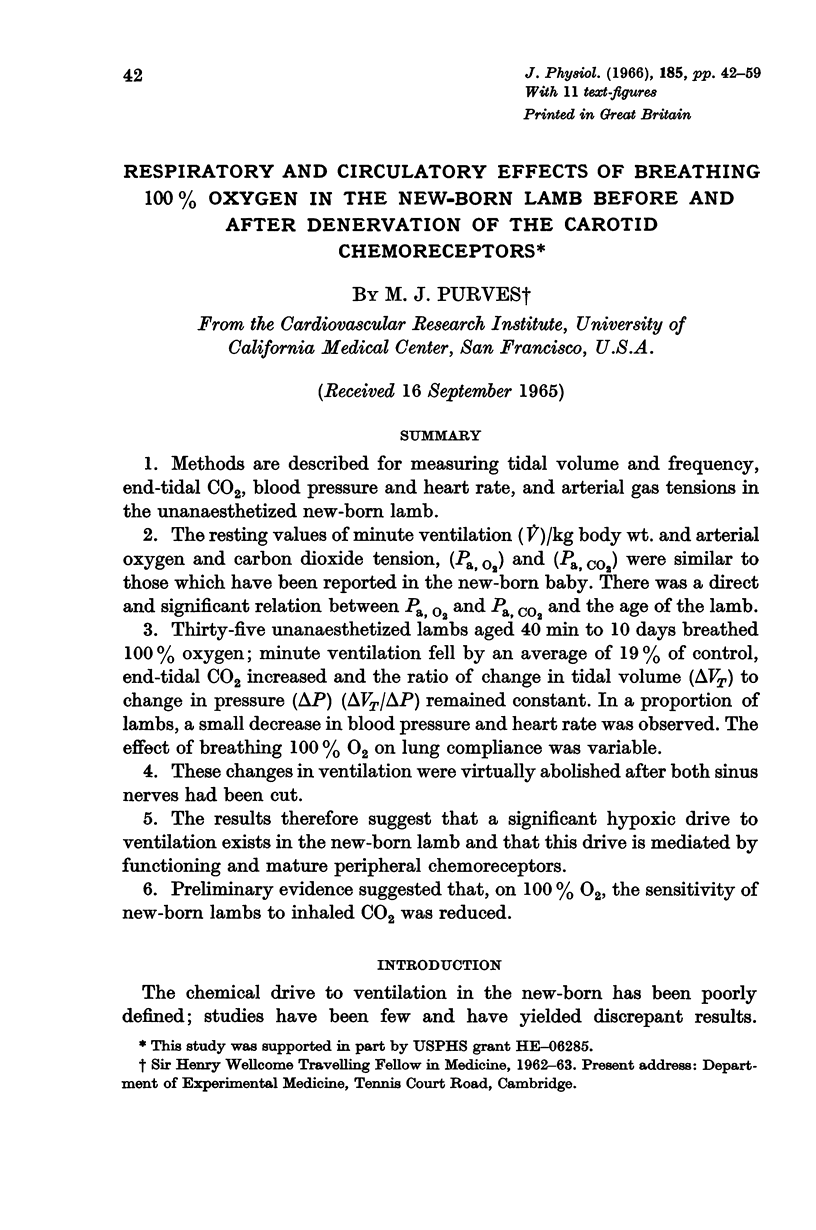




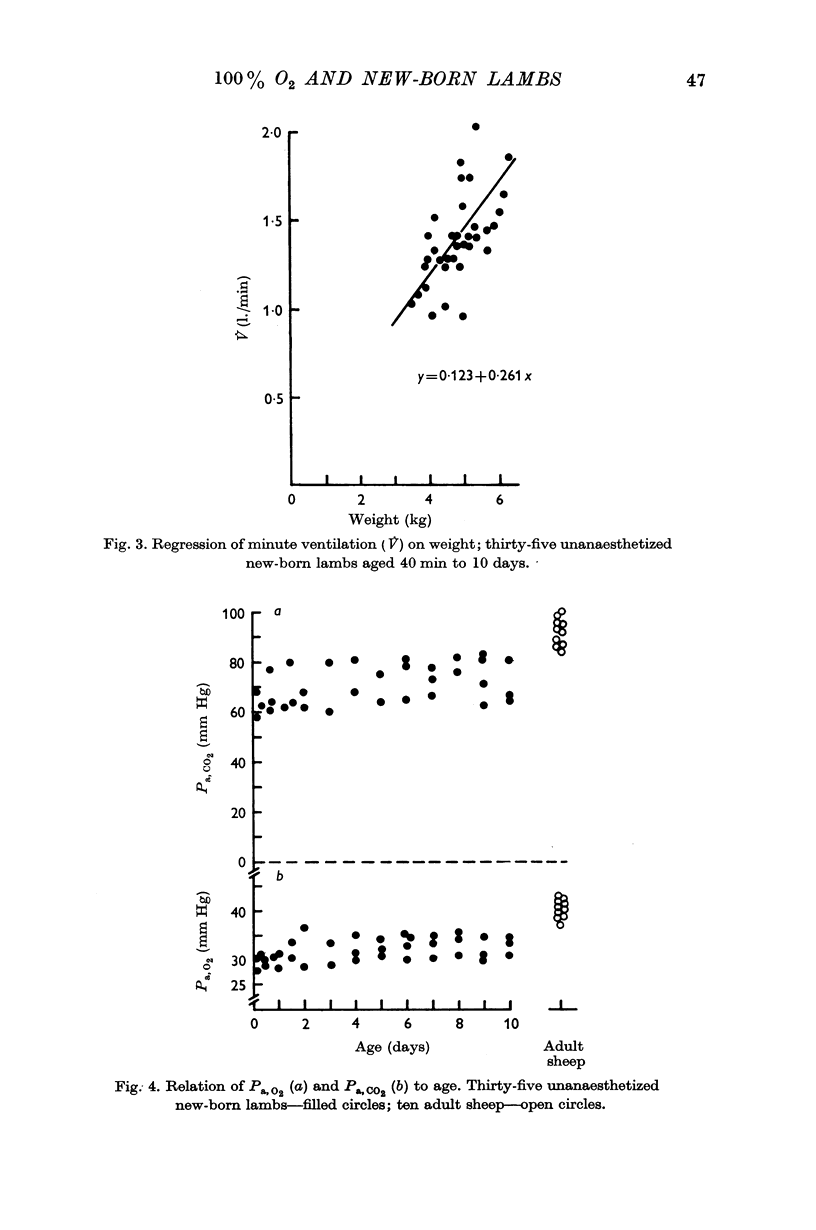
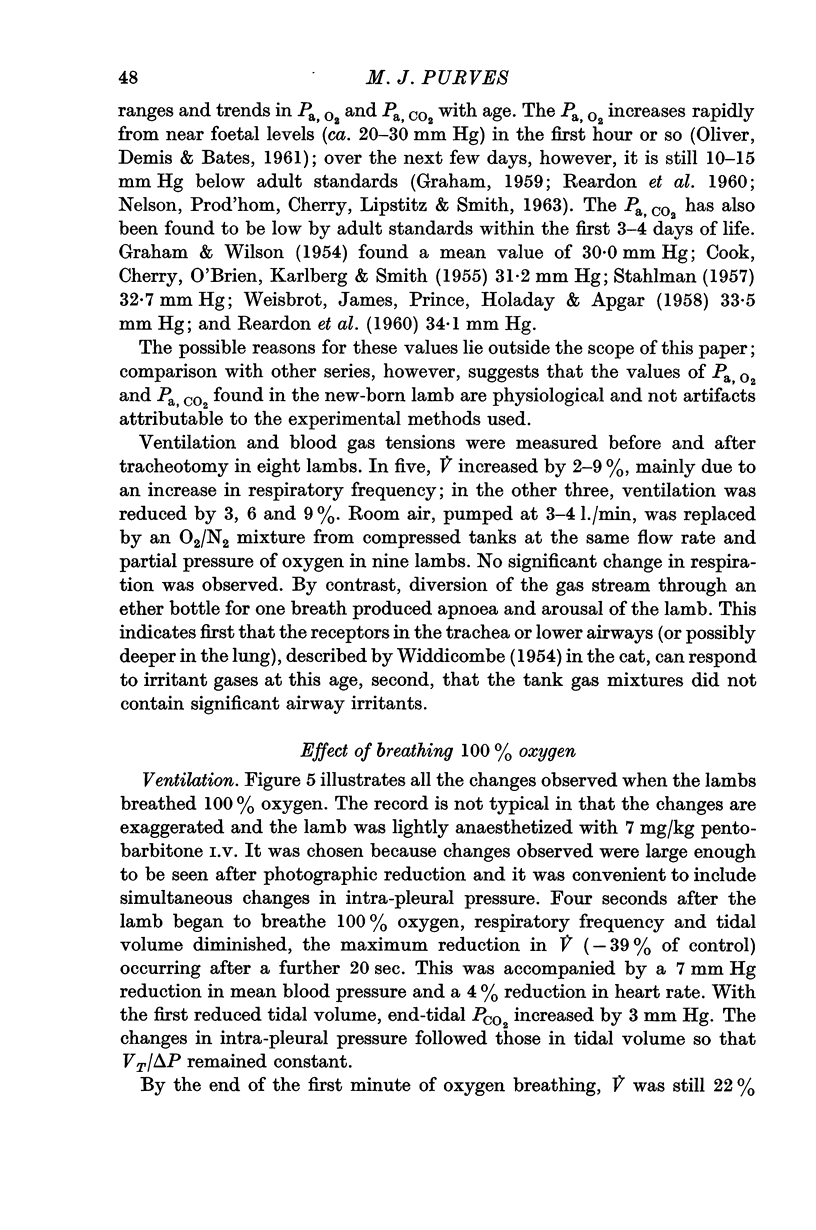




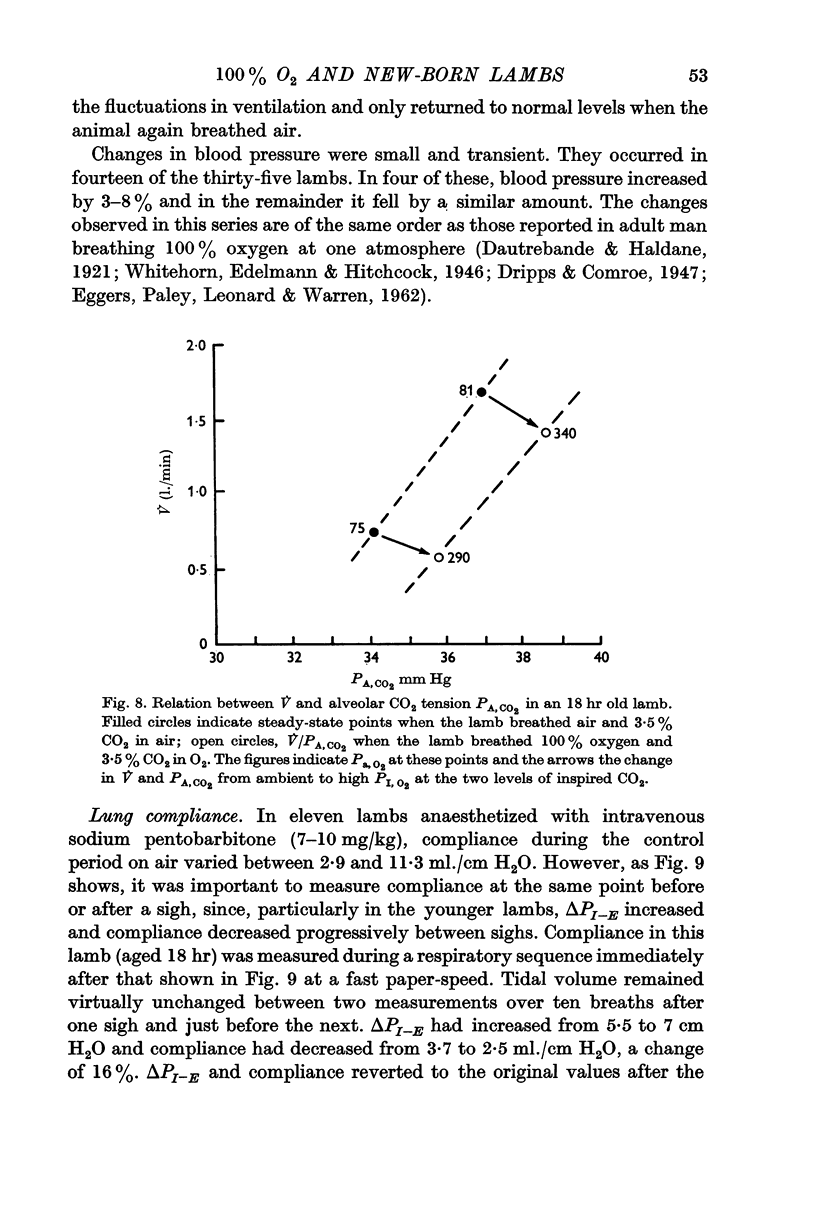
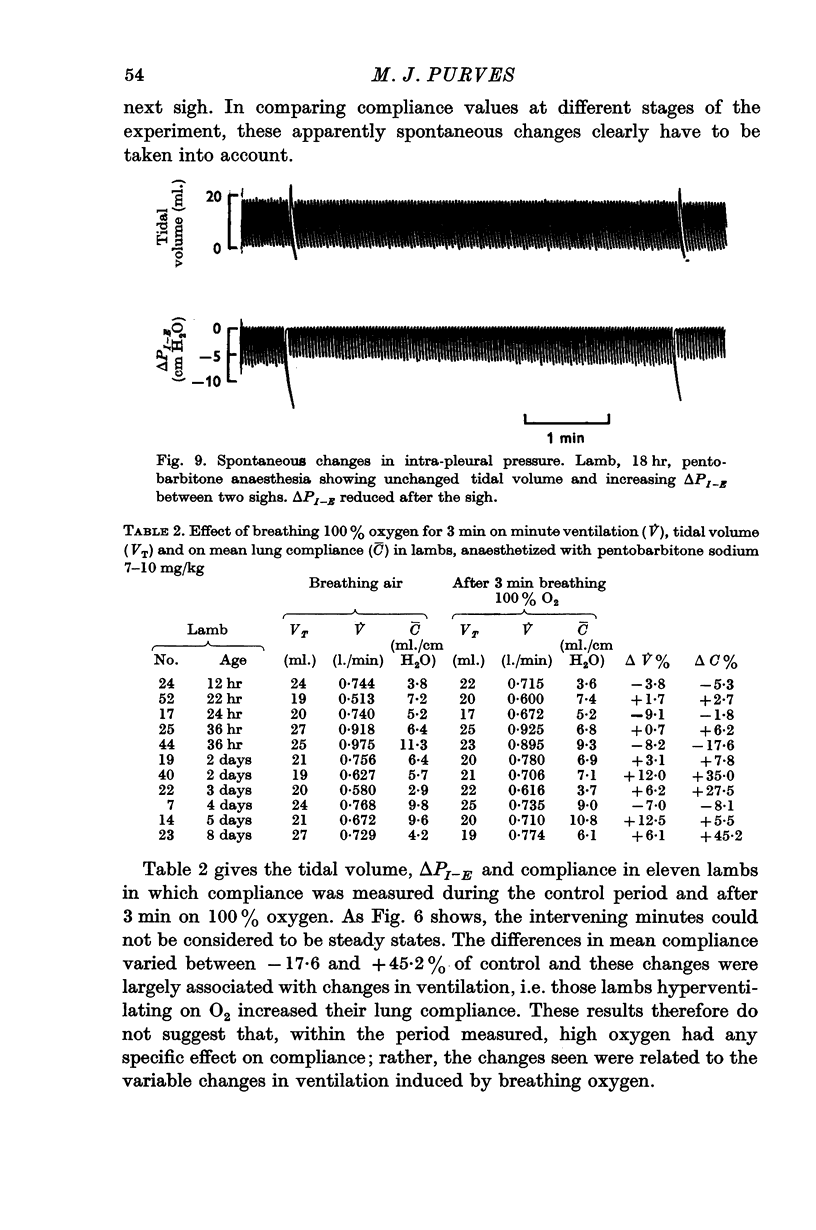

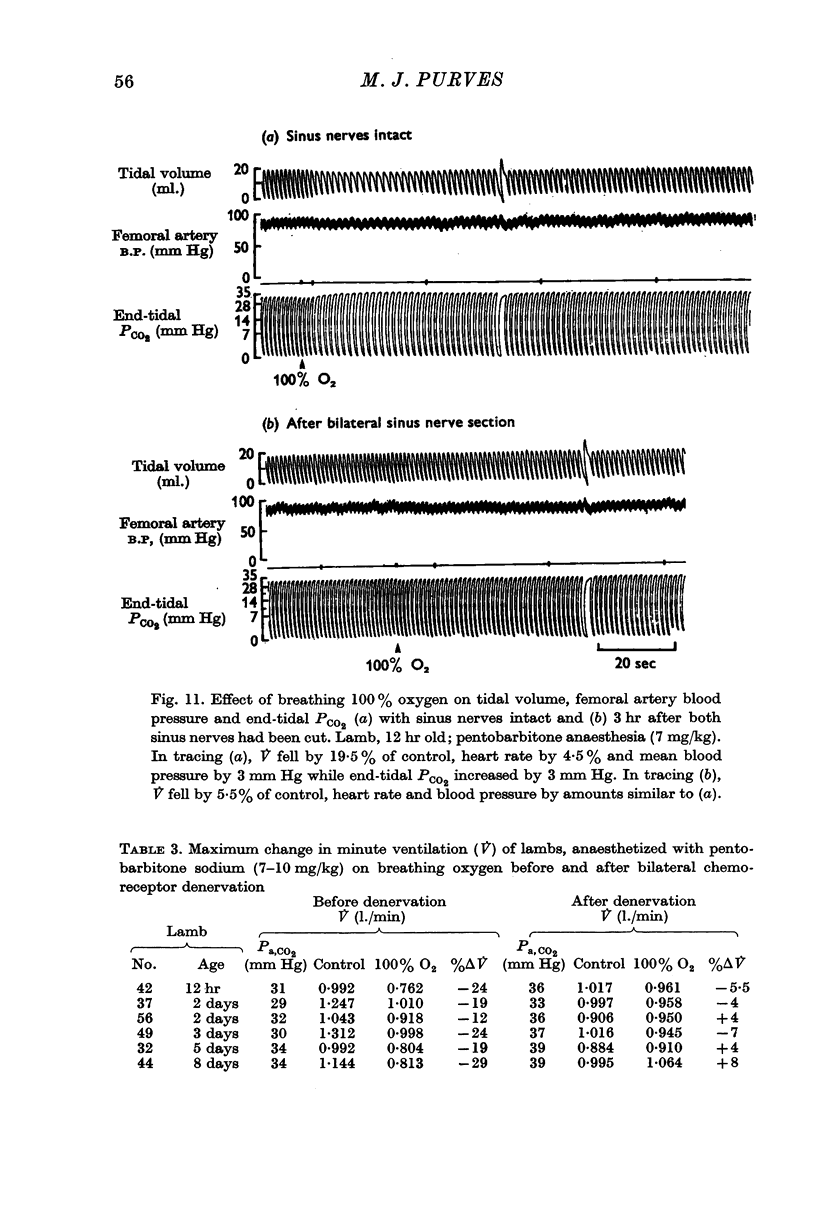

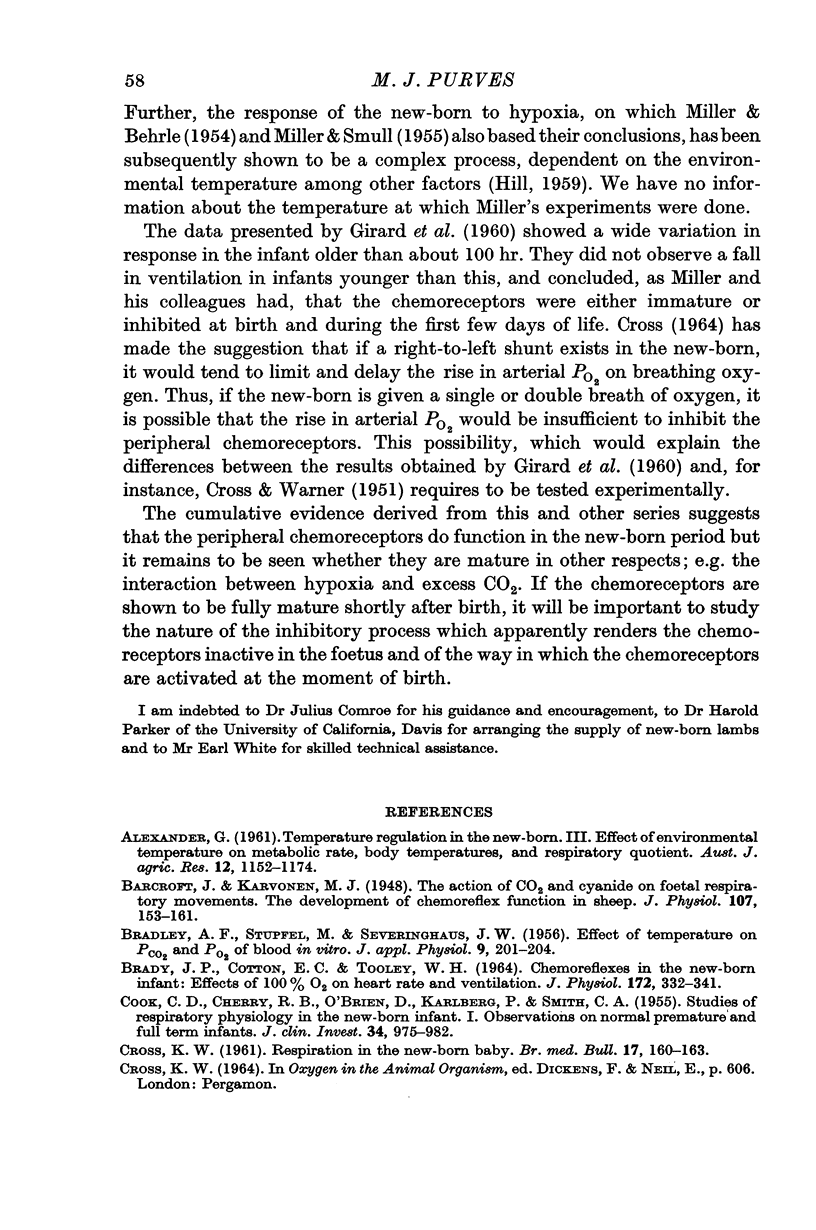
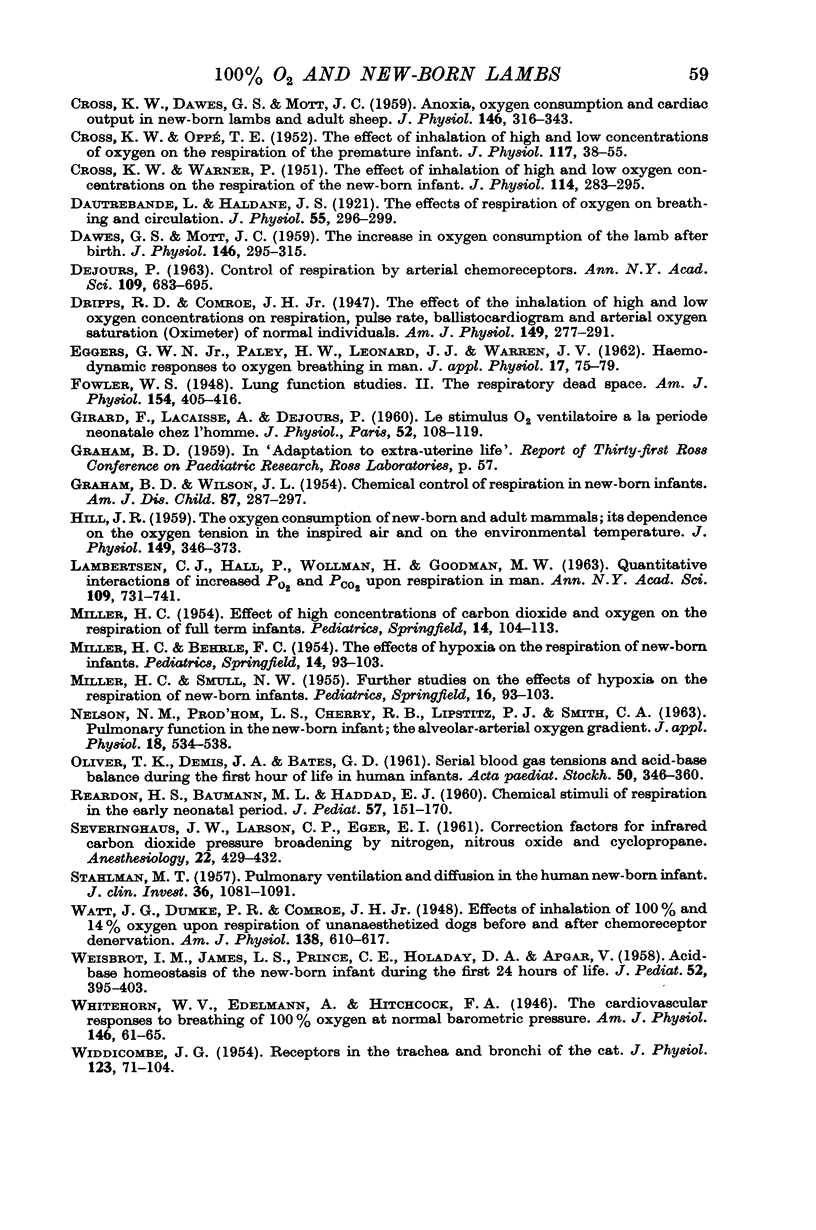
Selected References
These references are in PubMed. This may not be the complete list of references from this article.
- BRADLEY A. F., SEVERINGHAUS J. W., STUPFEL M. Effect of temperature on PCO2 and PO2 of blood in vitro. J Appl Physiol. 1956 Sep;9(2):201–204. doi: 10.1152/jappl.1956.9.2.201. [DOI] [PubMed] [Google Scholar]
- BRADY J. P., COTTON E. C., TOOLEY W. H. CHEMOREFLEXES IN THE NEW-BORN INFANT: EFFECTS OF 100 PER CENT OXYGEN ON HEART RATE AND VENTILATION. J Physiol. 1964 Aug;172:332–341. doi: 10.1113/jphysiol.1964.sp007421. [DOI] [PMC free article] [PubMed] [Google Scholar]
- Barcroft J., Karvonen M. J. The action of carbon dioxide and cyanide on foetal respiratory movements; the development of chemoreflex function in sheep. J Physiol. 1948 Mar 15;107(2):153–161. doi: 10.1113/jphysiol.1948.sp004258. [DOI] [PMC free article] [PubMed] [Google Scholar]
- COOK C. D., CHERRY R. B., O'BRIEN D., KARLBERG P., SMITH C. A. Studies of respiratory physiology in the newborn infant. I. Observations on normal premature and full-term infants. J Clin Invest. 1955 Jul;34(7 Pt 1):975–982. doi: 10.1172/JCI103165. [DOI] [PMC free article] [PubMed] [Google Scholar]
- CROSS K. W., DAWES G. S., MOTT J. C. Anoxia, oxygen consumption and cardiac output in new-born lambs and adult sheep. J Physiol. 1959 May 19;146(2):316–343. doi: 10.1113/jphysiol.1959.sp006195. [DOI] [PMC free article] [PubMed] [Google Scholar]
- CROSS K. W., OPPE T. E. The effect of inhalation of high and low concentrations of oxygen on the respiration of the premature infant. J Physiol. 1952 May;117(1):38–55. [PMC free article] [PubMed] [Google Scholar]
- CROSS K. W. Respiration in the new-born baby. Br Med Bull. 1961 May;17:160–164. doi: 10.1093/oxfordjournals.bmb.a069892. [DOI] [PubMed] [Google Scholar]
- CROSS K. W., WARNER P. The effect of inhalation of high and low oxygen concentrations on the respiration of the newborn infant. J Physiol. 1951 Jul;114(3):283–295. doi: 10.1113/jphysiol.1951.sp004620. [DOI] [PMC free article] [PubMed] [Google Scholar]
- DAWES G. S., MOTT J. C. The increase in oxygen consumption of the lamb after birth. J Physiol. 1959 May 19;146(2):295–315. doi: 10.1113/jphysiol.1959.sp006194. [DOI] [PMC free article] [PubMed] [Google Scholar]
- DEJOURS P. Control of respiration by arterial chemoreceptors. Ann N Y Acad Sci. 1963 Jun 24;109:682–695. doi: 10.1111/j.1749-6632.1963.tb13497.x. [DOI] [PubMed] [Google Scholar]
- Dautrebande L., Haldane J. S. The effects of respiration of oxygen on breathing and circulation. J Physiol. 1921 Aug 3;55(3-4):296–299. doi: 10.1113/jphysiol.1921.sp001972. [DOI] [PMC free article] [PubMed] [Google Scholar]
- GIRARD F., LACAISSE A., DEJOURS P. [Ventilatory O2 stimulus in the neonatal period in man]. J Physiol (Paris) 1960 Jan-Feb;52:108–109. [PubMed] [Google Scholar]
- GRAHAM B. D., WILSON J. L. Chemical control of respiration in newborn infants. AMA Am J Dis Child. 1954 Mar;87(3):287–297. doi: 10.1001/archpedi.1954.02050090275003. [DOI] [PubMed] [Google Scholar]
- HILL J. R. The oxygen consumption of new-born and adult mammals. Its dependence on the oxygen tension in the inspired air and on the environmental temperature. J Physiol. 1959 Dec;149:346–373. doi: 10.1113/jphysiol.1959.sp006344. [DOI] [PMC free article] [PubMed] [Google Scholar]
- LAMBERTSEN C. J., HALL P., WOLLMAN H., GOODMAN M. W. Quantitative interactions of increased Po2 and Pco2 upon respiration in man. Ann N Y Acad Sci. 1963 Jun 24;109:731–742. doi: 10.1111/j.1749-6632.1963.tb13502.x. [DOI] [PubMed] [Google Scholar]
- MILLER H. C., BEHRLE F. C. The effects of hypoxia on the respiration of newborn infants. Pediatrics. 1954 Aug;14(2):93–103. [PubMed] [Google Scholar]
- MILLER H. C. Effect of high concentrations of carbon dioxide and oxygen on the respiration of fullterm infants. Pediatrics. 1954 Aug;14(2):104–113. [PubMed] [Google Scholar]
- MILLER H. C., SMULL N. W. Further studies on the effects of hypoxia on the respiration of newborn infants. Pediatrics. 1955 Jul;16(1):93–103. [PubMed] [Google Scholar]
- OLIVER T. K., Jr, DEMIS J. A., BATES G. D. Serial blood-gas tensions and acid-base balance during the first hour of life in human infants. Acta Paediatr. 1961 Jul;50:346–360. doi: 10.1111/j.1651-2227.1961.tb08185.x. [DOI] [PubMed] [Google Scholar]
- REARDON H. S., BAUMANN M. L., HADDAD E. J. Chemical stimuli of respiration in the early neonatal period. J Pediatr. 1960 Aug;57:151–170. doi: 10.1016/s0022-3476(60)80049-2. [DOI] [PubMed] [Google Scholar]
- SEVERINGHAUS J. W., LARSON C. P., EGER E. I. Correction factors for infrared carbon dioxide pressure broadening by nitrogen, nitrous oxide and cyclopropane. Anesthesiology. 1961 May-Jun;22:429–432. doi: 10.1097/00000542-196105000-00015. [DOI] [PubMed] [Google Scholar]
- STAHLMAN M. T. Pulmonary ventilation and diffusion in the human newborn infant. J Clin Invest. 1957 Jul;36(7):1081–1091. doi: 10.1172/JCI103503. [DOI] [PMC free article] [PubMed] [Google Scholar]
- WEISBROT I. M., JAMES L. S., PRINCE C. E., HOLADAY D. A., APGAR V. Acid-base homeostasis of the newborn infant during the first 24 hours of life. J Pediatr. 1958 Apr;52(4):395–403. doi: 10.1016/s0022-3476(58)80059-1. [DOI] [PubMed] [Google Scholar]
- WIDDICOMBE J. G. Receptors in the trachea and bronchi of the cat. J Physiol. 1954 Jan;123(1):71–104. doi: 10.1113/jphysiol.1954.sp005034. [DOI] [PMC free article] [PubMed] [Google Scholar]


